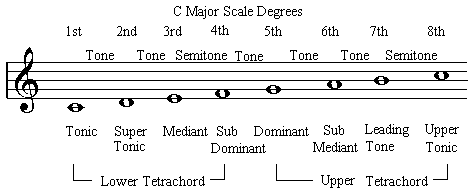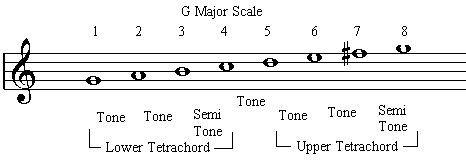A scale is a series of sounds proceeding in alphabetical order from any given note to its octave (The same note played higher).
Scales are of two types, Diatonic & Chromatic. The term Diatonic is applied to scales which consist of tones & semitones. (eg a tone is the distance from one fret up to the note two frets higher, from say F to G. A semitone is the distance from one fret up to the very next fret, from say F to F# )
A scale which consists entirely of semitones is called a Chromatic scale. There are also other types of diatonic scales which may only have 5 notes. These are called Pentatonic scales.
The notes of a Diatonic scale are called degrees and each degree has a specific name these are;
| Scale Degree | Description |
|---|---|
| Tonic | The note from which the Key and Scale take their names |
| Supertonic | The note over or above the Tonic |
| Mediant | The note Midway between the Tonic and the Dominant |
| Sub Dominant | The note under the Dominant |
| Dominant | Named because of the powerful or Dominant influence in deciding the Key |
| Sub Mediant | The note Midway between the Sub Dominant and the Upper Tonic |
| Leading Note | Named because of its natural progression to lead or resolve up to the Upper Tonic |
| Upper Tonic | The note One Octave higher than the Tonic or Key note |
The following diagram illustrates the procession of Tones and Semitones in a Major Scale
The procession of Tone Tone Semitone is the basic building block of all the Major Scales. By equally dividing the major scale below, we can see that two identical groups of Tones and Semitones are formed
The two groups both consist of two tones followed by a semitone. These sets of 4 notes are called Tetrachords and as we shall see, form the basis of all major scale formations.

The upper Tetrachord of C Major can now be taken to form the Lower Tetrachord of the scale of G Major. By adding a new Tetrachord above the Lower Tetrachord of G Major the G Major scale has been formed. Notice that there is also a tone between the Lower and Upper Tetrachords, Also that the F note must be made sharp in order to preserve the Tone Tone Semitone sequence.
If we now took the Upper Tetrachord of G Major starting with the note D and then added another Tetrachord above it, the D Major scale would be formed. We can now see how all the major scales and keys have been formed. This also explains why each key or scale has the number of sharps or flats in it, so as to preserve the Tone Tone Semitone format.

By adding Tetrachords above the Lower Tetrachord, scales are formed with sharps. If however, we were to keep the Lower tetrachord of C Major and add a Tetrachord below it we would have created the scale of F Major. By adding Tetrachords below the Lower Tetrachord of a scale the keys with flats are formed.
